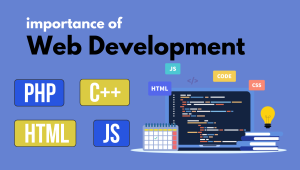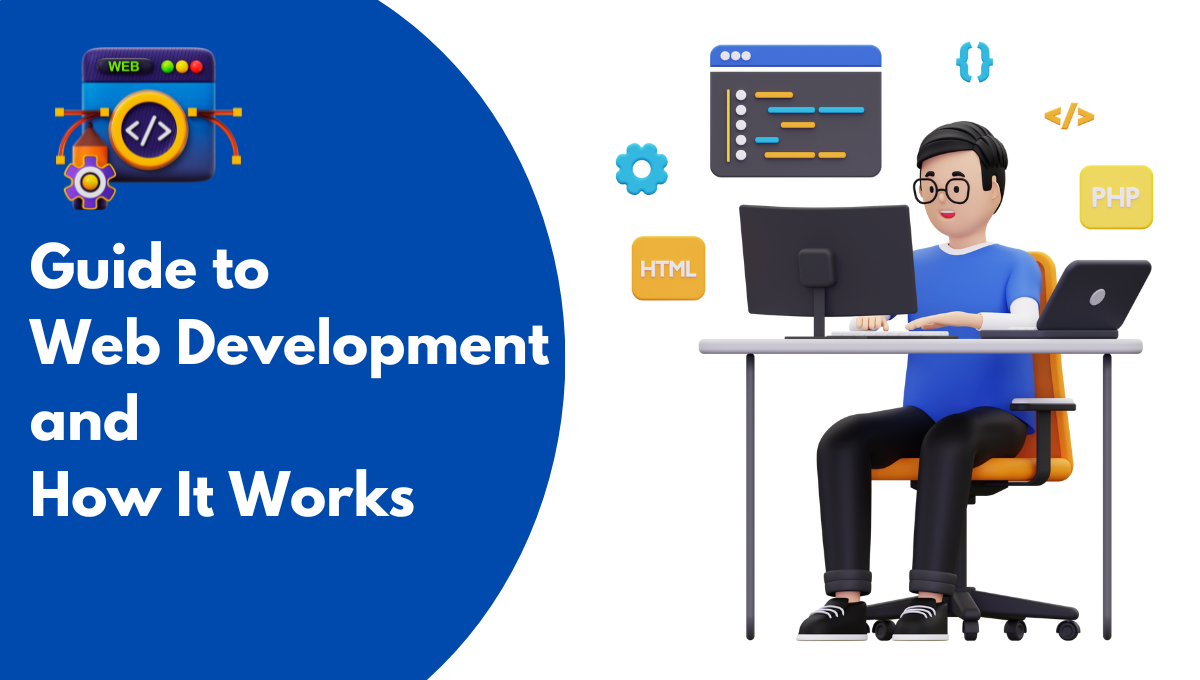Web development is the process of creating and developing web pages using various technologies and frameworks. Understanding web development terminologies and methodologies can be unclear for many. This comprehensive guide aims to demystify web development, making it detailed and easy to understand for professional and ordinary individuals alike.
Digital technologies are revolutionizing our economy, surrounded by great inventions. Web developers harness these technologies to create software that utilizes the web, making lives easier. Exploring different types of web development and popular frameworks helps in comprehending this invention better. Embracing this process enables a deeper grasp of the ordinary operations that shape our online lives through developed web pages.
Table of Contents
ToggleWhat is Web Development?
Building websites and web development applications involves a meticulous process led by skilled web developers. These heroes of the digital realm use various programming languages such as HTML, CSS, and JavaScript for designing and creating intuitive and responsive front-end features. This is integral as it ensures that the developed sites seamlessly work across multiple devices and screen sizes, contributing to a positive user experience. In a world with a staggering 1.98 billion websites as of September 2022, the internet continues to grow, making the expertise of web developers paramount in crafting online spaces that work properly and seamlessly.
To achieve this, developers often leverage popular frameworks and tools to streamline operations and code logic, maintaining the functionality of company website development and web applications. As businesses increasingly recognize the importance of a robust online presence, the demand to hire skilled developers, like those at Radixweb, is on the rise. These professionals play a crucial role in the ongoing success of the internet, ensuring that the ever-expanding digital landscape remains operational and user-friendly in the coming days.
Why is Web Development Important?

In the digital era, the fundamental importance of web development for a business cannot be ignored. A well-crafted website design not only enhances brand visibility but also serves as the forefront of your online presence. Your website or web application is the key to reaching out to a vast audience. It’s not just about showcasing your services and products, but about creating a connection with your audience.
A company website development strategy, when considered as a priority, becomes a lifeline for sustaining in a competitive market. In the long term, it transforms mere visitors into lifetime customers, emphasizing the foremost need for a strategic approach to web development applications.
For a business owner, the journey into the digital realm requires a keen understanding of what web development truly impacts. Web developers, led by the likes of Stephen, a Software Engineering Manager at Microsoft, must consider every aspect. Beyond just an online presence, your website or web application must be an attractive hub that not only attracts an audience but also converts them into customers.
From addressing technical bottlenecks to implementing innovative features, the goal is to build a website that not only satisfies immediate needs but also communicates effectively with customers. In this quest, the company website development process becomes a continuous cycle of improvement, staying in tune with the latest trends and strategies, shaping your company’s identity and professionalism.
What are Web Development Basics?
When digging out information on web development, one will chance upon the fundamentals of HTML, CSS, and JavaScript. These three are the core pillars of web development stacks—technologies that dominate the industry. For any learner planning to become a web developer, a basic understanding of these is crucial.
Mastering these not only makes one an expert but also aids in developing amazing websites that every customer and business will crave. Understanding the company website development journey involves grasping how web development applications rely on HTML, CSS, and JavaScript to make the web work.
In the realm of web development, the prowess of HTML, CSS, and JavaScript stands tall. These are the foundational elements that construct company website development and web development applications. Having a solid grip on these is pivotal for aspiring web developers.
Mastering the basics leads to expertise and the ability to craft websites that not only cater to customer needs but also enhance business prospects. Understanding the significance of HTML, CSS, and JavaScript in web development is the key to making the web work effectively for company website development and web development applications.
1.HTML – Markup Language
HTML, or Hyper Text Markup Language, is the standard markup language for designing and creating web pages. It uses elements, tags, and attributes to define the structure of sections and paragraphs within a page. Links in HTML indicate connections to other pages or resources, shaping the format and display of websites. According to dictionary.com, HTML is the common format used to tag data within an electronic document, setting standards for web development.
For web development applications, understanding and mastering HTML is fundamental as it serves as the backbone for the creation and formatting of web pages on the internet.
2.CSS – Designing Language
Cascading Style Sheets (CSS) is a stylesheet language that describes how HTML markup language documents should be presented on the web page. By adding styles through CSS, one can create unique CSS styles to make the web page more attractive and pleasant for end-users. It deals with formatting elements, defining fonts, colors, and spacing to craft an attractive and catchier presentation.
Used in conjunction with HTML and XML, CSS plays a pivotal role in structuring and designing a web page, making it visually appealing and user-friendly. In the realm of web development, understanding CSS is vital, as it significantly impacts web development applications and web development salaries by shaping the visual appeal of digital interfaces.
3.JavaScript – Programming Language
In web development, a programming language plays a pivotal role. Popular choices like JavaScript, with its first-class functions, cater to both front-end and back-end needs. Utilized as a versatile scripting language, it’s not confined to browsers but extends to non-browser environments like Node.js. This language is interpreted in just-in-time compiled fashion, offering efficiency.
Noteworthy frameworks such as AngularJS, jQuery, TezJS, and ReactJS simplify tasks. In diverse applications like Apache CouchDB and Adobe Acrobat, it proves its mettle. These robust tools are instrumental in handling complicated tasks across web development landscapes, influencing salaries in the industry.
Most Popular Web Development Tools
Web development encompasses a dynamic landscape, catering to beginners and experienced professionals alike. The first step involves mastering HTML, CSS, and JavaScript—the foundational trio shaping websites and web applications. Using user-friendly tools like GitHub for version control and Chrome Developer Tools for debugging ensures efficient and quality outcomes. Employing automation through tools like Grunt streamlines tasks while prioritizing security features via frameworks like Ruby on Rails safeguards projects.
As you progress, embracing technologies such as ReactJS, Angular, or Vue.js amplifies performance. With Postman testing and Docker containerization, web development applications become more robust. These tools, from text editors to prototyping tools, shape the landscape of web development—ultimately defining web development salaries and the trajectory of web development applications.
Web Development Technologies
In the world of web development, the pace of evolving technology never ceases, presenting developers with a myriad of latest technologies to master. To implement these advancements effectively, a good command over the basics of web development is crucial. With multiple options available in the market, choosing the right tools holds the key. Developers must know their way around HTML, CSS, and JavaScript while being adept in languages like Python, Ruby on Rails, and Java. Understanding frameworks such as Node.js, AngularJS, and WordPress adds depth.
Moreover, a grip on databases like MongoDB or SQL Server is a must. Embracing HTTP, REST, and various API formats like JSON and XML ensures seamless integration. As web development salaries rise, the demand for skilled professionals escalates, prompting web development companies in Pakistan to seek individuals well-versed in these technologies. Staying updated with the latest offerings and having the prowess to improve enterprise web development will continue to define the industry’s trajectory amidst this ever-changing landscape.
Web Development Frameworks
In 2024, the world of web development frameworks continues to evolve, offering the best ready-made tools and components. These frameworks, designed to be reliable, come equipped with snippets of code and templates that significantly aid developers in crafting robust web applications. They harness extensive libraries and web resources including web services and web APIs.
For web development companies in Pakistan, leveraging these advancements not only enhances efficiency but also influences web development salaries by optimizing productivity and delivering high-quality solutions to clients.
Most Popular Front-End Frameworks
ReactJS is a popular JavaScript library for building user interfaces. It follows a component-based architecture and utilizes a virtual DOM for efficient rendering. With a declarative approach, React makes it easy to create reusable UI components for interactive and dynamic experiences. Developed by Facebook, React is widely used in modern single-page applications and provides a robust frontend framework that emphasizes maintainability, scalability, and high performance.
Using features like JSX, state, and lifecycle methods, React simplifies DOM manipulation and event handling, making it a versatile choice for web development. React’s flexibility extends to mobile applications with React Native, allowing developers to use the same component tree for both web and mobile platforms.
TezJS is a powerful JavaScript library focused on functional programming for building reactive web applications. It excels in real-time performance, providing a declarative and asynchronous approach to manage state using observables. TezJS is designed for maintainability and scalability, emphasizing simplicity in backend development. With a strong emphasis on composition, concurrency, and event-driven programming, TezJS is well-suited for handling complex operations and computations in the Tezos blockchain ecosystem, especially for developing smart contracts.
Angular is a comprehensive frontend framework developed by Google, utilizing TypeScript and following the MVC architecture. It excels in building single-page applications with features like two-way data binding, directives, and dependency injection. Angular’s modular structure with components, modules, and services enhances maintainability and scalability.
The use of RxJS observables enables reactive programming, and tools like Angular CLI ensure performance optimization and support for progressive web apps. Angular is a structured and enterprise-level solution for web development applications and company website development, providing a robust framework for creating dynamic content across various platforms.
In the world of web development, Vue.js stands out as a progressive JavaScript framework. Known for its simplicity and reactivity, Vue.js adopts the MVVM architecture and offers declarative rendering for building dynamic user interfaces. With a lightweight and fast ecosystem, Vue.js includes features like directives, two-way data binding, and reactive components. Vue.js prioritizes maintainability and scalability while providing tools like Vue Router and Vuex for efficient state management.
Whether using Vue CLI for project setup or exploring options like VuePress for server-side rendering, Vue.js is a versatile choice for web development applications and creating company website development.
Most Used Backend Frameworks
In web development, various frameworks like Ruby on Rails and Django play a pivotal role. Ruby on Rails, known for its Model-View-Controller (MVC) architecture, emphasizes Convention over configuration and offers a RESTful approach. It leverages Active Record for seamless database interactions.
Meanwhile, Django, a Pythonic web framework, utilizes Model-View-Template (MVT) and Object-Relational Mapping (ORM). Its high-level, scalable nature makes it a go-to choice for web development applications and company website development. In the realm of frameworks, Flask stands out as a microframework in Python, offering lightweight and extensible solutions. With its Pythonic approach, it caters well to web development, serving as an ideal choice for front-end web development.
Meanwhile, Laravel in PHP shines with its elegant syntax and Modern PHP features. Utilizing tools like Artisan and the Blade templating engine, it accelerates web development tasks for company website development. Similarly, CodeIgniter, another PHP framework, is known for its rapid development capabilities owing to its lightweight nature and adherence to the MVC architecture, making it a suitable choice for web development applications.
Web Development Languages
In web development, there’s a vital split between front-end and back-end tasks. Software engineers and programmers collaborate to build a feature-rich website or web application. The front-end brings visuals and interfaces to life, using HTML, CSS, and JavaScript – client-side languages dictating how a site looks and communicates. Conversely, backend web development deploys server-side languages like Java and Python for logic, handling databases, and running servers.
To be a full-stack developer, mastering both ends is key, acquiring a border skillset of expertise in programming languages. Learning web development applications means grasping these aspects, be it for company website development or a complex web application.Understanding what is front end web development delves into the front-end interface – the core of user interaction. It involves coding defining visual elements, buttons, and graphics users engage with. Aspiring professional web developers seek tips from seasoned experts, learning popular web development languages like JavaScript.
Meanwhile, backend tasks focus on the backend application – managing databases and servers for smooth communication between the user’s browser and the server. To master web development, understanding both front-end and back-end nuances is the prime objective for developers aiming at creating impactful digital experiences.
- JavaScript
In the field of web development applications, React.js stands out as a prominent JavaScript library for crafting engaging user interfaces. Employing a declarative syntax and efficient virtual DOM, React.js simplifies the creation of reusable UI components within a modular component-based architecture. Whether designing dynamic web applications or efficient single-page applications, React.js, supported by a robust ecosystem, empowers web developers to enhance the user experience through innovative UI rendering and effective state management using React hooks. For effective company website development and proficient front-end web development, Vue.js emerges as a valuable tool.
Offering a progressive framework with reactive programming and declarative rendering, Vue.js provides a structured approach for building responsive web development applications. With features like Vue components, Vue Router, and Vuex, it facilitates efficient state management, making it an excellent choice for achieving native-like performance in cross-platform development. The integration of TypeScript further boosts developer productivity, combining the advantages of a statically typed language with the ease of the JavaScript ecosystem.
- Python
Django, a high-level web framework for Python, follows the MVT architecture (Model-View-Template) to ensure robust and scalable web applications. With its powerful Django ORM facilitating Object-Relational Mapping for seamless interaction with database models, and the Django Admin providing an automatic admin interface, the framework boasts a built-in authentication system and robust security features.
URL routing, a flexible template engine, and the Django REST framework for creating RESTful APIs further contribute to its versatility. The active Django community and comprehensive Django documentation make it an ideal choice for diverse web development projects.On the other hand, Flask, a microframework for Python, stands out for its lightweight and simple design, making it easy to use for developing web applications. It employs Flask routes and URL patterns for effective navigation, with Jinja2 templating engine powering dynamic Flask templates.
The Flask views facilitate request handling and response generation, while various Flask extensions like Flask-WTF, Flask-SQLAlchemy, and Flask-RESTful enhance its functionality. With a supportive Flask community and thorough Flask documentation, it excels in creating dynamic and efficient web development applications.
- Ruby
- Jekyll
- Swift
- HTML
- CSS
- Sass
- Scss
- PHP
What are the Types of Web Development?
Understanding the three main types of web development is crucial when discussing the functionality of a website. Each type plays a vital role in developing web solutions.
- The first type involves the frontend, where users click links and interact with the website interface. This is where the “Pay Now” button resides, giving the site its look and feel.
- The second type is the backend process, the behind-the-scenes code logic that powers the functionality, such as the payment page. Web developers are responsible for creating both the frontend and backend, ensuring a seamless user experience.
- Their expertise in these types of web development helps users easily navigate, understand, and pay on a web page. This comprehensive approach by a web development company ensures a website’s success, reflecting the skills reflected in web development salaries.
Front End Web Development
A leading web development company in Pakistan specializes in creating and designing innovative websites and applications. Our skilled developers use cutting-edge front-end frameworks and technologies such as HTML, CSS, and JavaScript to craft a seamless user interface. Through meticulous research and adherence to modern-age trends, we ensure that your website’s design not only looks appealing but is also responsive across various devices—be it mobile devices, desktops, or tablets.
By incorporating the best security practices, we guarantee the web content is not only visually impressive but also safe. As per Statista and Ahrefs, we leave no stone unturned to impress and build a web app that stands among the top 100 most visited websites, giving you higher chances of gaining traffic.
Back End Web Development
Within the realm of web development, the backend acts as the crucial foundation, managing the background processes that power a seamless web application. Behind the scenes, skilled developers employ languages such as Node.JS, Java, PHP, and SQL to craft the code logic that directs the interaction with the database. Meanwhile, the frontend focuses on creating an engaging user experience on the visible side of the web page. The coordination of Application Programming Interfaces (APIs) and frameworks forms the architectural backbone, connecting the frontend and backend for a cohesive website.
In essence, both frontend and backend are integral to web application development, collaborating to deliver an exceptional digital experience. For top-notch company website development, prioritizing technical excellence and hiring skilled teams, such as those at Radixweb, becomes paramount.
Full Stack Web Development
The dynamic field of full-stack web development involves a crucial role played by developers in creating end-to-end digital applications by managing both client-side and server-side aspects. The development process integrates front-end and back-end processes, ensuring smooth functioning of the application’s core.
Responsible for designing and enhancing the entire web design, these professionals upgrade their skills to meet the project’s requirements and stay well-versed in the latest web development trends, such as Artificial Intelligence, Blockchain, Deep Learning, Machine Learning, and Cloud development.
Indeed, the demand for full-stack developers is prominent, especially in the United States, where full-stack web development companies may offer excellent career options with an average salary of USD 119,539. Whether working for company website development or agency web development, a full-stack web developer plans, programs, and executes projects from scratch, making the right choice in using popular technology stacks like MEAN Stack or MERN Stack, which are scalable and flexible for various project sizes.
What is the Best Web Development Process?
Choosing the right custom web application development company is a crucial step in bringing your web app to life. At Radixweb, we understand the significance of aligning your thoughts with the budget and timeframe for a true and successful project.
Our step-by-step web development process involves determining the entire web design and development outline, breaking down tasks and functionalities into manageable milestones, ensuring the best way to monitor progress throughout the project. We implement and adhere to a systematic approach, allowing you to witness the implementation of your project in a controlled and efficient manner.
In the end-to-end web development process, considering several things is vital for a well-documented and predictable series of procedures. Whether it’s company website development or agency web development, we address every component of your website development project to meet the given deadline.
Our experienced team works collaboratively, ensuring that each stage of the web development life cycle is complete and that the web development resources are utilized effectively. This ensures that every stakeholder’s needs are met, and the project is delivered on time, achieving a common objective through the different stages of the web development process.
- Requirements Gathering
Company website development is a crucial step for any business or consulting company aiming to establish a strong online presence. The main objective of this web development project is to build a website that serves the purpose of not only providing product information but also gathering the required information about the target audience and their needs. The development team will focus on understanding the business goals and the key features necessary to meet those objectives.
By asking relevant questions to the clients, the team will create a roadmap to achieve the goals of the company website development and ensure it caters to the multiple services offered by the consulting company. This strategic approach will help in building a website that not only showcases the expertise of the agency in web development but also addresses the specific business needs of the clients.
- Planning
Successful agency website development requires meticulous planning and a well-defined methodology. Thorough research and analysis of user needs precede setting clear goals for the project. Effective UI/UX design involves strategic layout planning and thoughtful wireframing. Allocating resources and creating a realistic budget for the development ensure cost-effective outcomes. The use of appropriate languages and a robust framework contributes to the platform’s success.
A well-structured sitemap and engaging content creation enhance the overall user experience. We believe in an intuitive approach to align the plan with the company’s information architecture. The key to achieving success lies in harmonizing the software and development with the unique needs of the users in agency web development.
- Designing
At the foremost basic stage of website design, UI designers at WebFx play an essential role in conducting thorough research on consumer behaviors. Consumers judge 62% of the website within 90 seconds of their initial interaction with a product, based on its color, layout, and overall UI/UX. This makes the web design stage crucial, as it impacts the approval of clients. Designers are responsible for creating a website that not only looks like, feels like, and works seamlessly but is also highly responsive on various devices.
They integrate visual components, content, layouts, navigations, images, and videos to deliver a feature-rich and user-friendly experience. Moreover, experienced web designers stay up to date with the latest web development trends, incorporating the most efficient designs and integrating the latest technologies and frameworks. A skilled web designer must also know front-end technologies like HTML and CSS, ensuring compliance with several web standards and compatibility across various web browsers.
- Development
In web development, a company’s website is the prime platform to communicate the message to the target audience. The process involves intertwining front-end and back-end development. Front-end, dealing with the client-side, employs web development languages and frameworks like React, Angular, and Vue.js to craft engaging designs with animations and effects.
Meanwhile, backend development manages server-side operations, handling requested information and business logic for database storage. Bridging these aspects requires technical knowledge to ensure a seamless user-server interaction, aligning the content with user needs and implementing effective call-to-actions. This harmonious fusion in company website development optimizes user experience and leverages the potential of popular web frameworks to advantageously display the product or service information.
- Testing and Deployment
Dynamic web development necessitates a fusion of diverse skills and technical knowledge for crafting a standout company website. Mastery of various web development languages and frameworks, flawless deployment, and meticulous resolution of glitches ensure optimal compatibility.
Our team of experts engages in a sequence of activities, incorporating essential plugins and enhancing functionality and performance for the target audience. Rigorous testing precedes live deployment, where our QA team resolves encountered bugs or errors, ensuring the final touch meets the highest standards. With Radixweb, assure multiple on-page SEO amendments, giving your website the green flag in the competitive market.
- Support and Maintenance
An outsourcing company for company website development ensures a seamless journey from project requirements to deployment. They handle maintenance, updates, and performance analysis, focusing on enhancing features for competitive visibility. With continuous support, they satisfy users and foster long-term partnerships. This web development agency, akin to David Karp’s approach with Tumblr, streamlines the project, offering very cost-efficient solutions that let businesses focus on their core. Handing over the final stage, they put minds at ease, providing care even after the project’s completion.
How to Hire Web Developers for Your Web Development Project?
In 2024, the Internet continues to connect users worldwide, and according to Datareportal, the total number of websites has reached billions. With the increasing rise in new inventions and technology since 2022, the demand for web developers and IT experts has surged. In the US alone, Statista reports a rise in the number of developers to 200,000 in 2023, and it’s projected to reach 229,000.
For company website development or agency web development, a good choice involves careful planning and execution. One can either hire remote developers or opt for a dedicated web development team from a reputable software development outsourcing company like Radixweb.
After finalizing the project requirements, size, and budget, you have two options: executing it in-house or handing over the project to a third-party company. To make the right choice, consider the tips and guide provided by Radixweb, ensuring that all your questions are answered and doubts are cleared before going into detail with the web development process.
Hire Web Developers from Radixweb in Simple Steps
Identify the obstacles in your business
Clearly define your project concept and scale
Establish a project budget
Specify the necessary skills for developers
Select the development model that suits your needs
Reach out to Radixweb to communicate your requirements
Assess the capabilities of developers and review their portfolio
Conduct interviews with candidates and create a shortlist
Determine the preferred payment model
Conclusion:
In conclusion, navigating the vast landscape of web development requires a strategic approach. This comprehensive guide unravels the intricate web of processes involved in bringing digital ideas to life. From defining business challenges and outlining project budgets to selecting the right development model and engaging with skilled developers, the journey is both enlightening and empowering. Connecting with experts at Radixweb amplifies this experience, ensuring seamless communication of project requirements.
Evaluating developer potential and portfolios becomes a crucial step, leading to informed decisions. Interviews culminate in a curated list, and choosing an appropriate payment model adds the final touch. Ultimately, this guide is a beacon, illuminating the intricate workings of web development for both novices and seasoned professionals alike.
FAQS
1.What is a web developer?
Web developers create functional, user-friendly websites and web applications. They may write code, develop and test new applications, or monitor site performance and traffic. Front-end developers focus on the user-facing side of their work, while back-end developers make websites functional and secure.
2.What is web development and how does it work?
Web development is the work involved in developing a website for the Internet (World Wide Web) or an intranet (a private network). Web development can range from developing a simple single static page of plain text to complex web applications, electronic businesses, and social network services.
3.What are the 5 stages of website development?
- Step 1: Design. This is the fun part.
- Step 2: Review. Once the team has had some time to work through the design process.
- Step 3: Develop. Now that the design is approved, it is time for the website to go to the developer.
- Step 4: Test.
- Step 5: Launch!
4.What are 3 types of web development?
There are three main types of web development: front-end development, back-end development, and full stack development.
5.What is the best software for web development?
- CMS Hub: Best All-in-One Web Design Software for Beginners.
- WordPress: Best Free Blog Design Software for Beginners.
- Figma: Best Free Collaborative Wireframing Tool for Beginners.
- Sketch: Best User Interface Design Tool for Mac Users.
- Lunacy: Best Free User Interface Design Tool for Windows Users.





